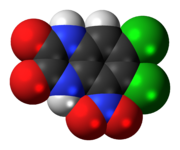 | |
 | |
| Clinical data | |
|---|---|
| ATC code |
|
| Identifiers | |
| |
| CAS Number | |
| PubChem CID | |
| ChemSpider | |
| UNII | |
| CompTox Dashboard (EPA) | |
| Chemical and physical data | |
| Formula | C8H3Cl2N3O4 |
| Molar mass | 276.03 g·mol−1 |
| 3D model (JSmol) | |
| |
| |
Licostinel (INN) (code name ACEA-1021) is a competitive, silent antagonist of the glycine site of the NMDA receptor (Kb = 5 nM).[1][2][3] It was under investigation by Acea Pharmaceuticals as a neuroprotective agent for the treatment of cerebral ischemia associated with stroke and head injuries but was ultimately never marketed.[1][2][4] In clinical trials, licostinel did not produce phencyclidine-like psychotomimetic effects at the doses tested, though transient sedation, dizziness, and nausea were observed.[4][5] In addition to its actions at the NMDA receptor, licostinel also acts as an antagonist of the AMPA and kainate receptors at high concentrations (Kb = 0.9 μM and 2.5 μM, respectively).[3]
See also
References
- ^ a b Small DL, Tauskela JS (31 January 2007). "Glutamate Receptor Pharmacology: Lessons Learned from the Last Decade of Stroke Trials". In Gill S, Pulido O (eds.). Glutamate Receptors in Peripheral Tissue: Excitatory Transmission Outside the CNS. Springer Science & Business Media. pp. 36–. ISBN 978-0-306-48644-9.
- ^ a b Gusev EI, Skvortsova VI (30 April 2003). "Primary Neuroprotection". Brain Ischemia. Springer Science & Business Media. pp. 249–. ISBN 978-0-306-47694-5.
- ^ a b Wilding TJ, Huettner JE (March 1996). "Antagonist pharmacology of kainate- and alpha-amino-3-hydroxy-5-methyl-4-isoxazolepropionic acid-preferring receptors". Molecular Pharmacology. 49 (3): 540–546. PMID 8643094.
- ^ a b Boyce SG, Rupniak N (1 January 2002). "Behavioural studies on the potential of NMDA receptor antagonists as analgesics". In Sirinathsinghji DJ, Hill RG (eds.). NMDA Antagonists As Potential Analgesic Drugs. Springer Science & Business Media. pp. 151–. ISBN 978-3-7643-6011-5.
- ^ Chizh BA, Headly PM (28 May 2013). "N-Methyl-D-Aspartate (NMDA) Receptors as Target for Pain Therapy". In Bountra C, Munglani R, Schmidt WK (eds.). Pain: Current Understanding, Emerging Therapies, and Novel Approaches to Drug Discovery. CRC Press. pp. 567–. ISBN 978-0-203-91125-9.
